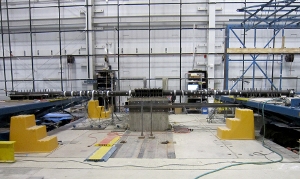Aug 7 2014
Cornell civil engineers report that retrofitting pipelines with “cured-in-place pipe” (CIPP) linings – flexible tubular membranes saturated with thermosetting resin – would prevent earthquake damage to seismically vulnerable, 50- to 100-year-old cast iron U.S. pipelines.
 Pipeline specimens were anchored to shake tables to simulate the passage of a seismic wave through two adjacent push-on joints. Experiments took place at a University at Buffalo laboratory. Credit: NEES
Pipeline specimens were anchored to shake tables to simulate the passage of a seismic wave through two adjacent push-on joints. Experiments took place at a University at Buffalo laboratory. Credit: NEES
Their findings would allow public and private utilities to take advantage of improvements in seismic resistance and to renovate aging pipelines that make up an important part of the country’s critical civil infrastructure.
The research – conducted by principal investigator Thomas O’Rourke, the Thomas R. Briggs Professor in Engineering; Cornell earthquake engineers; and a team from State University of New York at Buffalo – was presented at Quake Summit 2014, the annual meeting for the National Science Foundation’s George E. Brown Jr. Network for Earthquake Engineering Simulation, a shared network of laboratories based at Purdue University. This year’s summit was part of the 10th U.S. National Conference on Earthquake Engineering, July 21-25 in Anchorage.
A CIPP lining can be installed in water and wastewater pipelines without digging them up. The technique involves the remote installation of fiber-reinforced polymer (FRP) linings inside underground pipelines through trenchless construction procedures.
“Using no-dig technologies and FRP liners allows for retrofitting pipelines in place without the substantial business and traffic interruptions and safety concerns related to conventional excavation with repair or replacement,” O’Rourke said.
Full-scale dynamic testing of underground lifeline systems was conducted in the Structural Engineering and Earthquake Simulation Laboratory at the University at Buffalo, which hosts two high-performance, six-degrees-of-freedom shake tables. Pipeline specimens were anchored to both shake tables to simulate the passage of a seismic wave through two adjacent push-on joints.
Tests of CIPP-retrofitted pipeline response to abrupt ground displacement and fault movement were performed at the Cornell Large-Scale Lifeline Test Facility. This facility replicates the effects of full-scale fault rupture on underground pipelines, electric and telecommunication cables, and other conduits for resources and services.
Results from physical testing and analytical modeling showed that the CIPP-retrofitted pipelines are able to accommodate very high levels of transient ground motion and moderate levels of permanent ground deformation.
The team partnered with Insituform Technologies Inc. and Progressive Pipeline Management LLC, which lined the experimental pipe specimens, and with the Los Angeles Department of Water and Power, which donated the ductile iron pipe used for test specimens and hosted university/industry conferences on earthquake resilience at their facilities. The team also partnered with California State University at Los Angeles.
Team members included Cornell associate professor Harry Stewart; Cornell graduate researchers Dimitra Bouziou, Brad Wham and Christina Argyrou; Cornell lab managers Tim Bond and Joe Chipalowski; SUNY Buffalo professors Andre Filiatrault and Amjad Aref, and a SUNY Buffalo graduate research assistant.
The Quake Summit conference presentation was titled “Performance of Water Pipelines Retrofitted with Cured in Place Pipe Liner Technology Under Transient Earthquake Motions."